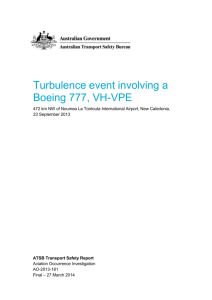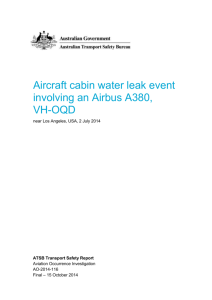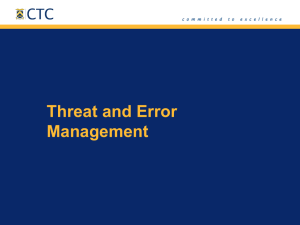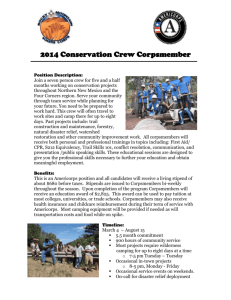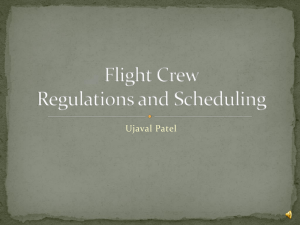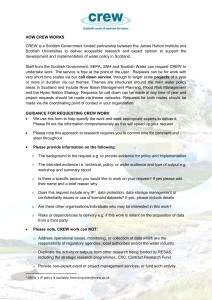DOCX
advertisement
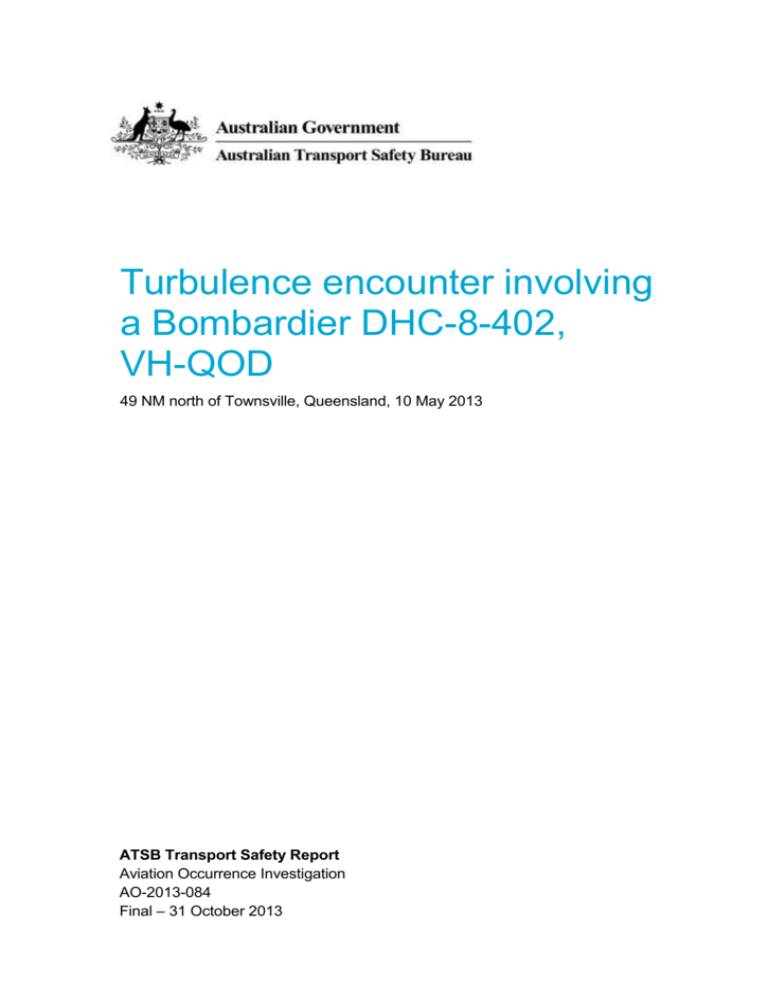
Turbulence encounter involving a Bombardier DHC-8-402, VH-QOD 49 NM north of Townsville, Queensland, 10 May 2013 ATSB Transport Safety Report Aviation Occurrence Investigation AO-2013-084 Final – 31 October 2013 Released in accordance with section 25 of the Transport Safety Investigation Act 2003 Publishing information Published by: Postal address: Office: Telephone: Facsimile: Email: Internet: Australian Transport Safety Bureau PO Box 967, Civic Square ACT 2608 62 Northbourne Avenue Canberra, Australian Capital Territory 2601 1800 020 616, from overseas +61 2 6257 4150 (24 hours) Accident and incident notification: 1800 011 034 (24 hours) 02 6247 3117, from overseas +61 2 6247 3117 atsbinfo@atsb.gov.au www.atsb.gov.au © Commonwealth of Australia 2013 Ownership of intellectual property rights in this publication Unless otherwise noted, copyright (and any other intellectual property rights, if any) in this publication is owned by the Commonwealth of Australia. Creative Commons licence With the exception of the Coat of Arms, ATSB logo, and photos and graphics in which a third party holds copyright, this publication is licensed under a Creative Commons Attribution 3.0 Australia licence. Creative Commons Attribution 3.0 Australia Licence is a standard form license agreement that allows you to copy, distribute, transmit and adapt this publication provided that you attribute the work. The ATSB’s preference is that you attribute this publication (and any material sourced from it) using the following wording: Source: Australian Transport Safety Bureau Copyright in material obtained from other agencies, private individuals or organisations, belongs to those agencies, individuals or organisations. Where you want to use their material you will need to contact them directly. Addendum Page Change Date ATSB – AO-2013-084 Turbulence encounter involving a Bombardier DHC-8-402, VH-QOD What happened Keep your seatbelt fastened 1 On 10 May 2013, at about 2000 Eastern Standard Time, a Sunstate Airlines Bombardier DHC-8-402 aircraft, registered VH-QOD (QOD), departed Townsville on a scheduled passenger flight to Cairns, Queensland. About 20 minutes into the flight, the aircraft was in the cruise at flight level (FL) 2 180 and flying in clear air when the aircraft encountered light turbulence. The captain immediately turned the seat belt sign on. A second later, the aircraft encountered abrupt severe turbulence.3 Source: ATSB 4 The autopilot disconnected and the captain, as pilot flying, assumed manual control of the aircraft. The flight crew reduced the speed of the aircraft to below the turbulence penetration speed.5 The turbulence event lasted about 10 seconds, during which time the aircraft climbed about 400 ft above the cruising altitude. The flight crew then re-engaged the autopilot and returned the aircraft to the assigned level. The flight crew did not observe the aircraft fly through any cloud and the weather radar did not show any significant weather for the entire flight. The weather radar was on the first officer’s multi-function display (MFD) display at all times throughout the flight. At the same time, the cabin crew had completed the food service and were handing out drinks. Both members of the cabin crew were standing when the aircraft encountered the turbulence and they impacted the roof before falling to the floor. Both sustained head injuries and one was knocked unconscious. One member of the cabin crew called the captain and advised him that both of them were bleeding from the head. There were drinks spilled throughout the cabin, some reading material had dislodged from the exit rows, but the cabin was otherwise secure. No passengers were injured in the incident as all had been seated with their seatbelts fastened. An able-bodied passenger (ABP) assisted with the other cabin crew member who was incapacitated. In the cockpit, the flight crew’s navigation bags dislodged from their aluminium frame and the captain’s bag had hit the roof before landing on his lap. The flight crew sustained minor injuries and objects were strewn throughout the cockpit. The flight crew conducted a check of all switches and circuit breakers, confirmed there were no warnings or cautions, and checked for any objects that may have fouled the rudders and other flight controls. The aircraft was fitted with a library, which was contained beneath the cockpit floor and secured by two latches. The lid had been dislodged by the turbulence and the contents were thrown around the cockpit. 1 2 3 4 5 Eastern Standard Time (EST) was Coordinated Universal Time (UTC) + 10 hours. At altitudes above 10,000 ft in Australia, an aircraft’s height above mean sea level is referred to as a flight level (FL). FL 180 equates to 18,000 ft. Severe turbulence is characterised by large, abrupt changes in altitude/attitude, with large variations in indicated airspeed. The aircraft may be temporarily out of control. Pilot flying (PF) and pilot monitoring (PM) are procedurally assigned roles with specifically assigned duties at specific stages of a flight. The PF does most of the flying, except in defined circumstances; such as planning for descent, approach and landing. The PM carries out support duties and monitors the PF’s actions and aircraft flightpath. Turbulence penetration speed (or manoeuvring speed) is defined as the maximum speed at which full abrupt control deflection can be made without exceeding the design load factor of the aircraft. ›1‹ ATSB – AO-2013-084 The captain reassured the cabin crew member and advised her to check that the passengers were uninjured. He made an announcement to inform and reassure the passengers and requested the cabin crew member secure the cabin for landing. The flight crew elected to continue the flight to Cairns and requested emergency services to be available on arrival. The aircraft landed in Cairns about 20 minutes later without further incident and the cabin crew were transferred to hospital. Recorded information The flight data recorder (FDR) was downloaded and provided to the Australian Transport Safety Bureau (ATSB) for analysis. The data showed that, during the incident, a positive vertical acceleration value of 1.5g was recorded, 1 second later a negative vertical acceleration of 1.4g was recorded, followed by a positive vertical acceleration of 1.6g. The negative vertical acceleration experienced by the aircraft caused the cabin crew and unsecured objects to be thrown into the air.6 Flight crew comments The flight crew reported that, due to the long moment arm of the DHC-8-400 series aircraft, the rear of the aircraft is more unpleasant during turbulence encounters. Both cabin crew members were at the rear of the cabin during the event. Meteorological information Bureau of Meteorology report The Bureau of Meteorology (BoM) provided the ATSB with a report detailing the weather at the time of the incident including conditions, forecasts, warnings, and satellite and radar imagery. The Townsville weather radar indicated a band of showers in the area of the incident up to FL195 that reached a peak altitude and intensity around 2010 as they passed from the east-south-east. The report indicated that this was likely to have contributed to atmospheric disturbances causing turbulent eddies. The report stated that a stable atmosphere between FL170 and FL200 may also have contributed to the incident. The showers (or any updraft) would have been unable to extend above this layer, which may have led to significant localised wind shear, and turbulent energy propagating horizontally. Area forecasts (ARFOR) In order to facilitate the provision of aviation weather forecasts by the BoM, Australia is divided into a number of forecast areas. The flight covered two adjacent areas, Area 44, which included Townsville Airport and Area 45, which included Cairns Airport. The Area 44 ARFOR, valid from 1500 to 0300 on 10 May 2013, forecast scattered cumulus clouds7 extending to 9,000 ft, becoming broken with tops at 18,000 ft in the vicinity of rain showers. Moderate turbulence was forecast in the larger cumulus clouds. The Area 45 ARFOR, valid from 1251 to 0300 on 10 May 2013, forecast scattered cumulus clouds extending to 15,000 ft, becoming broken near precipitation. Moderate turbulence was forecast in the cumulus clouds. 6 7 Vertical acceleration was recorded 8 times per second. The sensors that measure acceleration were located near the centre of gravity of the aircraft and the acceleration experienced at other points on the aircraft may have differed from the values recorded. Cloud cover is normally reported using expressions that denote the extent of the cover. The expression Few indicates that up to a quarter of the sky was covered, Scattered indicates that cloud was covering between a quarter and a half of the sky. Broken indicates that more than half to almost all the sky was covered, while Overcast means all the sky was covered. ›2‹ ATSB – AO-2013-084 Seat belt sign and cabin crew procedures The cabin crew reported that there were two normal procedures for illuminating the seat belt sign. If the flight crew were aware of possible turbulence approaching, they will contact the cabin crew to notify them, advise them how long they have to secure the cabin and switch on the seatbelt sign. The cabin crew will then advise the passengers and take their own seats. If it is urgent, the flight crew switch on the seatbelt sign and announce ‘cabin crew be seated’. This advises the cabin crew to be seated immediately and they will sit in the nearest available seat or wedge themselves into a position to be safe. In this incident, the flight crew illuminated the seat belt sign but were unable to make an announcement or contact the cabin crew prior to encountering the turbulence. One cabin crew member attempted to wedge herself between seats, but did not succeed. Safety action Whether or not the ATSB identifies safety issues in the course of an investigation, relevant organisations may proactively initiate safety action in order to reduce their safety risk. The ATSB has been advised of the following proactive safety action in response to this occurrence. Sunstate Airlines The operator conducted an internal investigation into the occurrence and identified actions for further review, although not specific to this incident. The operator has advised the ATSB that they propose taking the following safety actions: reviewing the usage of weather radar, and raising the weather radar reliability with the aircraft manufacturer sharing the investigation learnings with all flight crew and cabin crew. Safety message Clear air turbulence is often unexpected, is hard to detect, can occur when no clouds are visible, cannot be detected by aircraft radar and is common at the high altitudes that airliners cruise at. The ATSB publication Staying Safe against In-flight Turbulence reported that, between January 1998 and May 2008, there were 339 turbulence occurrences in Australia reported by airlines to the ATSB. These resulted in over 150 minor and serious injuries to passengers and cabin crew. The report noted that almost all injuries involved people who were not properly seated and did not have their seatbelts fastened. Staying Safe against In-flight Turbulence What can you do to stay safe? Put your seatbelt on, and keep it fastened when you are seated. Pay attention to the safety demonstration and any instructions given by the cabin crew. Read the safety information card in your seat pocket. In this event, all passengers were seated with their seat belts fastened, even though the seat belt sign had been switched off earlier. The fact that none of the passengers were injured highlights the benefits of keeping your seatbelt fastened during the flight. Cabin crew are at greater risk of injury during turbulence encounters as they are moving around the cabin and not seated with a seat belt fastened. ›3‹ ATSB – AO-2013-084 The following publications provide additional information: Staying Safe against In-flight Turbulence, www.atsb.gov.au/publications/2008/ar2008034.aspx Cabin Crew Safety 2001, January-February 2001, http://flightsafety.org/archives-andresources/publications/cabin-crew-safety/cabin-crew-safety-2001 . Roller Coaster Ride, how to minimise the risks of injury from in flight turbulence, in Flight Safety Australia May-June 2006, www.casa.gov.au/scripts/nc.dll?WCMS:STANDARD::pc=PC_91364 General details Occurrence details Date and time: 10 May 2013 – 2017 EST Occurrence category: Serious incident Primary occurrence type: Turbulence event Location: 49 NM north of Townsville, Queensland Latitude: 19° 15.15' S Longitude: 146° 45.92' E Aircraft details Manufacturer and model: Bombardier DHC-8-402 Registration: VH-QOD Operator: Sunstate Airlines Serial number: 4123 Type of operation: Air transport high capacity - passenger Persons on board: Crew – 4 Passengers – 17 Injuries: Crew – 4 minor Passengers – Nil Damage: Nil About the ATSB The Australian Transport Safety Bureau (ATSB) is an independent Commonwealth Government statutory agency. The Bureau is governed by a Commission and is entirely separate from transport regulators, policy makers and service providers. The ATSB's function is to improve safety and public confidence in the aviation, marine and rail modes of transport through excellence in: independent investigation of transport accidents and other safety occurrences; safety data recording, analysis and research; and fostering safety awareness, knowledge and action. The ATSB is responsible for investigating accidents and other transport safety matters involving civil aviation, marine and rail operations in Australia that fall within Commonwealth jurisdiction, as well as participating in overseas investigations involving Australian registered aircraft and ships. A primary concern is the safety of commercial transport, with particular regard to fare-paying passenger operations. The ATSB performs its functions in accordance with the provisions of the Transport Safety Investigation Act 2003 and Regulations and, where applicable, relevant international agreements. The object of a safety investigation is to identify and reduce safety-related risk. ATSB investigations determine and communicate the safety factors related to the transport safety matter being investigated. It is not a function of the ATSB to apportion blame or determine liability. At the same time, an investigation report must include factual material of sufficient weight to support the analysis and findings. At all times the ATSB endeavours to balance the use of material that could imply adverse ›4‹ ATSB – AO-2013-084 comment with the need to properly explain what happened, and why, in a fair and unbiased manner. About this report Decisions regarding whether to conduct an investigation, and the scope of an investigation, are based on many factors, including the level of safety benefit likely to be obtained from an investigation. For this occurrence, a limited-scope, fact-gathering investigation was conducted in order to produce a short summary report, and allow for greater industry awareness of potential safety issues and possible safety actions. ›5‹
